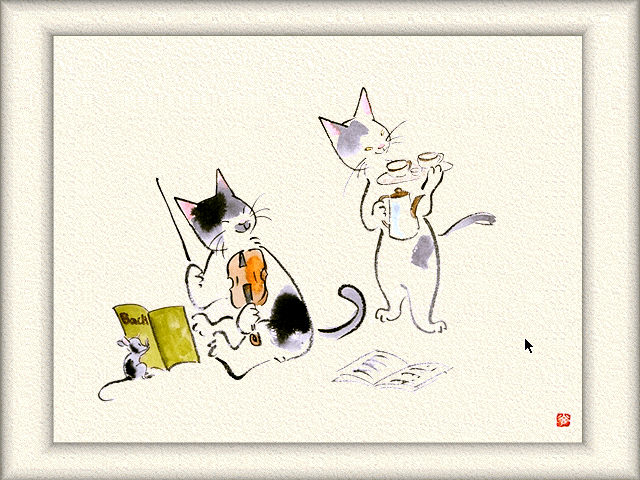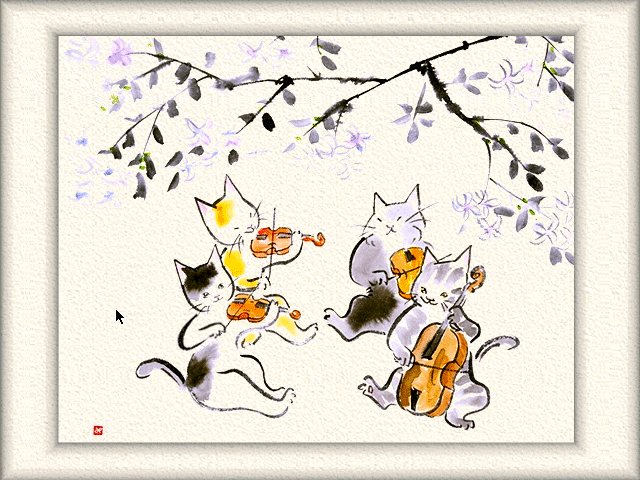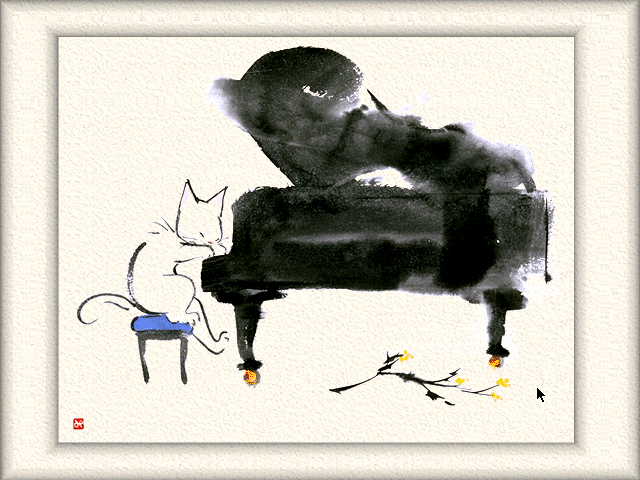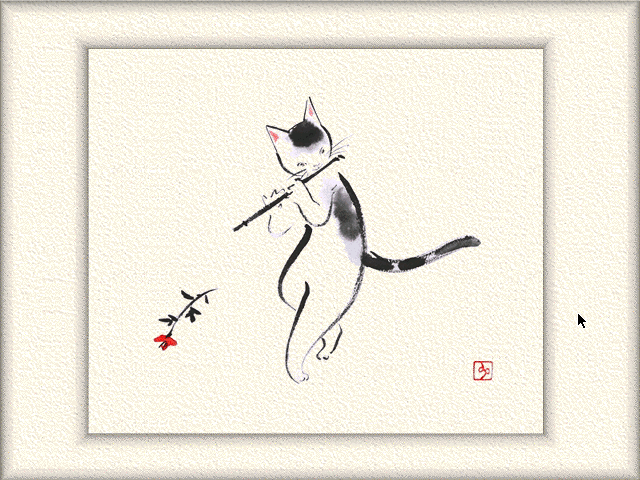Classical Cats
Sometimes, all you need is to take two things you love and put them together. For visual artist and classical musician Mitsuhiro Amada, that's classical art, classical music, and cats.

Amada has made a career out of pairing his particular interests. A classically-trained cellist who has performed with the Japan Philharmonic Orchestra[1], his art almost exclusively depicts cats playing classical instruments. He paints using the traditional Japanese sumi-e ink brush painting technique on textured paper which gives his work a slightly abstracted touch and allows him to imply a variety of settings without explicitly staging his cats anywhere in particular.
Above all, his cats are cute. He favours smiling faces and friendly poses with an overall pleasant vibe. They always seem to be enjoying their music, and most of his cats are performers rather than the audience or bystanders. It's not hard to want to spend time just enjoying these cats' company and imagining what music they're playing. If there's no audience in his paintings, the viewer can imagine themselves as the audience instead. Perhaps that's appropriate; Amada is known for holding hybrid art exhibition and classical music concert events he calls "tenonkai" (展音会)[2]; Classical Cats the disc is, in its own way, a virtual version of his real events.

Classical Cats is adapted from the 1994 book of the same name[3]. A bilingual Japanese/English publication, it pairs Amada's artwork with classical Japanese poetry. The CD-ROM uses the same paintings and poems as the original book, but updates the presentation to take advantage of the format. Most notably, it no longer just visually depicts classical music; each page is accompanied by a variety of well-known pieces performed by a sextet assembled specifically for this disc. With a mixture of flute, violin, piano, and irish harp, the players perform a variety of pieces from across the classical canon—Schubert, Bach, Haydn, Händel, and others. The poetry from the original disc is now also presented via readings instead of text; like the original book, it features a bilingual presentation, with the English poetry performed by its original translators.
The CD-ROM also takes advantage of the CD-ROM format to shake up the strictly linear format of the original book. This isn't an adventure game; there's still no "plot" or any gamic elements. But the navigation now takes advantage of the format by letting the reader pursue the book not only by browsing previous and next pages, but also by providing "up" and "down" navigation options that let the reader playfully jump from spot to spot in the book without regard to the original order. The digitized paintings now also feature limited animation in order to make the cats literally play the music. This is sometimes cute, but also limited by the technology and by the source material, which wasn't painted with animation in mind. It typically involves moving or rotating otherwise non-animated, and the effect can be crude.

Although Amada's sumi-e style draws from classical traditions, he brings a modernist perspective and influence from more recent graphic design trends. Compared to classical ink-wash artwork, he prefers cleaner and more defined outlines rather than the watery and ephemeral lines of classical sumi-e. It recalls the work of mid-century caritcaturists such as Al Hirschfield's line-art portraits in both his approach to linework and to negative space; many of his paintings leave entire regions of his characters with incomplete linework, using the empty regions to imply body language. The effect is further intensified by the digitization process. While the art is presented in high resolution and with excellent colour reproduction, the digitization nonetheless emphasizes the sharpness and definition of the linework in comparison with the original paintings.
A new edition was reissued in 2004 as, essentially, a print edition of the CD-ROM[4]. In addition to a reprint of the original book, it includes an audio CD that contains the same classical recordings and bilingual poetry readings as the CD-ROM. By necessity it's unable to incorporate any of the disc's other interactive features, so the reader is left to synchronize the music and poetry to the book themselves using the page cues printed on the disc.

As digital galleries go, Classical Cats may be simple. At the same time, it's charming and pleasant. Do you really need anything more from life than cute cats and music?
Classical Cats is out of print and scarce, but copies are occasionally available second-hand. It is difficult to run in Mac emulators because of the mixed-mode CD format, but it can be played on modern computers using version 2.8.0 or later of the software ScummVM.
1. Japanese Art in Berlin. The Music-inspired Paintings of AMADA Mitsuhiro. (2014, August 6). Berlin Global. https://www.berlinglobal.org/index.php?japanese-art-in-berlin-the-music-inspired-paintings-of-amada-mitsuhiro ↩
2. 雨田 光弘プロフィール. (n.d.). A.P.J. - Art Print Japan. Retrieved November 30, 2023, from http://www.apj-i.co.jp/artist/amada_mitsuhiro.html ↩
3. Amada, M., & Harris, T. J. G. (1994). Classical Cats. ALIS (Arts & Literature International Service). https://search.worldcat.org/title/1282491687 ↩
4. Amada, M., & Harris, T. J. G. (2004). Classical Cats (Revised ed. with classical music CD). ALIS (Arts & Literature International Service). ↩